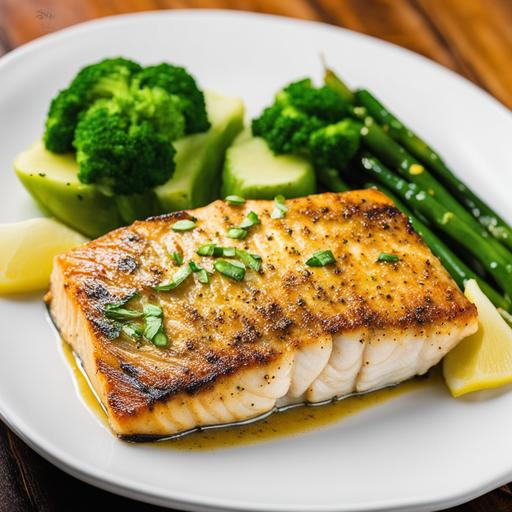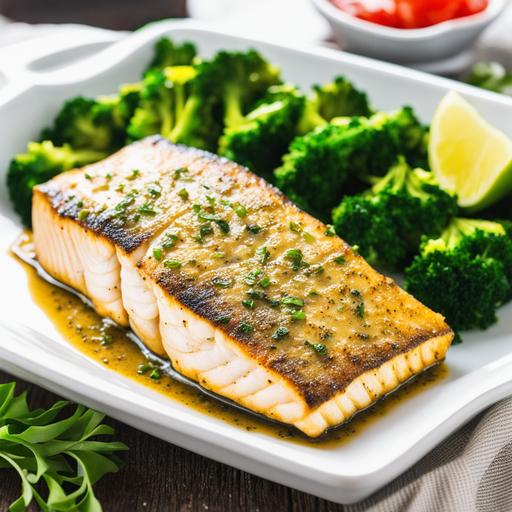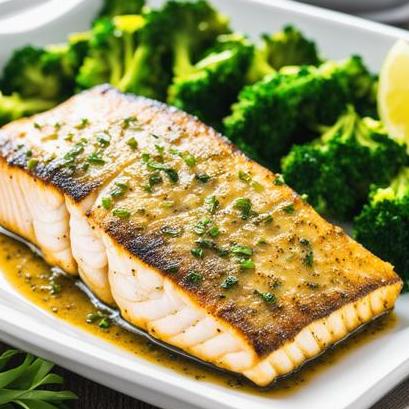
The Exquisite Mahi Mahi Oven Recipe: A Culinary Delight
Welcome to the world of culinary excellence! Today, we are delving into the realm of mahi mahi oven cooking. This luscious fish, known for its mild flavor and delicate texture, is a delight to the senses. With its versatility and numerous health benefits, mahi mahi has rightfully earned its place as a favorite amongst seafood enthusiasts. In this comprehensive guide, we will explore the art of preparing a succulent mahi mahi dish that will tantalize your taste buds and leave you craving for more.
The Food Science Behind Mahi Mahi
Before we dive into the culinary marvel that awaits us, let’s understand the food science behind mahi mahi. Also known as dolphinfish, mahi mahi belongs to the Coryphaenidae family. It has a dense, firm flesh that lends itself well to various cooking methods, including oven cooking. This fish is also packed with essential nutrients, such as lean protein, omega-3 fatty acids, and vitamins B and D. The low levels of mercury make it a healthier alternative to some other fish options.
Selecting the Perfect Mahi Mahi
When choosing mahi mahi for your oven recipe, freshness is key. Here are a few tips to ensure you pick the perfect catch:
-
Look for clear, bright eyes: Fresh mahi mahi should have clear and bright eyes, indicating its recent catch.
-
Evaluate the skin: The skin of a good mahi mahi should be shiny and vibrant, with a slightly metallic sheen.
-
Check for firmness: Gently press the fish fillets; they should feel firm and bouncing back, ensuring optimal freshness.
By paying attention to these details, you can ensure that you acquire the highest quality mahi mahi for your oven recipe.
Cleaning and Preparing the Mahi Mahi

Once you have selected the freshest mahi mahi, it’s time to prepare it for the oven. Follow these steps to ensure proper cleaning and preparation:
-
Rinse the fish: Give the mahi mahi fillets a gentle rinse under cold water to remove any surface dirt or debris.
-
Pat dry: Use a paper towel to blot the fillets, ensuring they are completely dry. This step allows for better seasoning and prevents the fish from sticking to the cooking surface.
-
Remove the skin (optional): While mahi mahi skin can enhance the flavor and texture when cooked properly, some prefer to remove it. To do so, grip the edge of the skin using a paper towel and slowly slide a sharp knife between the flesh and the skin.
-
Season generously: Sprinkle the fillets with salt, pepper, and any additional desired seasonings. Ensure both sides are evenly coated.
Properly cleaning and preparing the mahi mahi sets the foundation for a flavorful and perfectly cooked dish.
Tips for Perfectly Cooked Mahi Mahi

To achieve a mesmerizing meal, it’s important to keep a few crucial tips in mind:
-
Preheat the oven: Set your oven to the desired temperature (we recommend 375°F / 190°C) and allow it to thoroughly preheat before cooking. This ensures even cooking and prevents the fish from drying out.
-
Choice of cooking method: Mahi mahi can be prepared using various oven techniques such as baking, broiling, or roasting. Baking offers a gentle heat that allows the fish to cook evenly without losing moisture, making it an excellent choice.
-
Properly greasing the cooking surface: Apply a light coating of olive oil or non-stick cooking spray to the baking dish or sheet to prevent the fish from sticking.
-
Cooking time considerations: Mahi mahi fillets are typically cooked for about 10-15 minutes, depending on their thickness. Adjust the cooking time accordingly.
-
Avoid overcooking: Overcooked mahi mahi can result in a dry and rubbery texture. Keep a close eye on the fish during the cooking process to ensure it stays moist and tender.
-
Doneness check: To check if the mahi mahi fillets are cooked to perfection, insert a fork into the thickest part of the fillet. The fish should flake easily and appear opaque throughout.
-
Resting period: Allow the cooked fish to rest for a couple of minutes before serving. This allows the flavors to settle and ensures a juicier final result.
By following these helpful tips, you’ll be well on your way to creating a masterpiece with your mahi mahi oven recipe.
Variations to Elevate Your Mahi Mahi Dish

Feeling adventurous? Why not experiment with a few variations to further tantalize your taste buds? Here are some ideas to inspire your culinary creativity:
-
Citrus-infused twist: Squeeze fresh lemon or lime juice over the mahi mahi fillets before baking, adding a refreshing burst of citrusy flavor.
-
Tropical delight: Top the fillets with a delicious mango and pineapple salsa after cooking for a tropical twist on your mahi mahi dish.
-
Herbaceous bliss: Before seasoning, sprinkle the fillets with a medley of fresh herbs such as dill, basil, or thyme, complementing the delicate flavor of the fish.
-
Spicy kick: Add a pinch of cayenne pepper or sprinkle with your favorite spicy seasoning to give your dish a fiery punch.
Feel free to customize your mahi mahi recipe with these variations or create your own unique twists.
A Delightfully Tender Mahi Mahi Oven Recipe

Now that we have covered the essential details, it’s time to unveil a mouthwatering mahi mahi oven recipe. Prepare to be captivated by this exquisite dish!
Ingredients:
-
4 mahi mahi fillets (6-8 oz each)
-
2 tablespoons olive oil
-
1 teaspoon salt
-
1/2 teaspoon black pepper
-
1 lemon, sliced
-
Fresh herbs for garnish (optional)
Instructions:
-
Preheat your oven to 375°F / 190°C and lightly grease a baking dish with olive oil or non-stick cooking spray.
-
Place the mahi mahi fillets in the prepared baking dish, leaving some space between them.
-
Drizzle the olive oil over the fish fillets, ensuring they are evenly coated.
-
Sprinkle the salt and black pepper over the fillets, making sure to cover both sides.
-
Arrange the lemon slices on top of the fillets, adding a delightful hint of citrus.
-
Place the baking dish in the preheated oven and cook for approximately 12-15 minutes, or until the fish flakes easily when tested with a fork. Adjust cooking time based on the thickness of the fillets.
-
Once cooked, remove the baking dish from the oven and let the mahi mahi rest for a few minutes.
-
Garnish with fresh herbs, if desired, and serve with a side of your choice.
Overcook or Undercook: Finding the Sweet Spot
Achieving the perfect doneness is essential when cooking mahi mahi. While overcooking can lead to a dry and less flavorful result, undercooking can result in an unpleasant raw center. Here’s how to find the sweet spot:
-
Visual cues: The fish should appear opaque and flake easily when cooked correctly. Undercooked mahi mahi will still have a slightly translucent appearance, indicating it needs more time in the oven.
-
Temperature: Invest in a reliable kitchen thermometer to ensure the internal temperature of the fish reaches around 145°F (63°C). Testing the temperature at the thickest part of the fillet will give you an accurate reading for doneness.
By paying attention to visual cues and using a thermometer, you can achieve the ideal doneness for your mahi mahi, resulting in a perfectly tender and flavorful dish.
Final Thoughts
Congratulations! You are now equipped with all the knowledge to create a memorable mahi mahi oven recipe. From selecting the freshest fish to mastering the perfect cooking time, the journey to culinary excellence awaits. With a little practice and creativity, you can turn a simple mahi mahi fillet into a gourmet masterpiece that will leave your guests in awe. So, grab your apron, fire up your oven, and embark on a delightful culinary adventure with mahi mahi!
Sources
FAQS On Mahi Mahi Oven Recipe
What Is The Recommended Cooking Temperature For Mahi Mahi In The Oven?
The recommended cooking temperature for mahi mahi in the oven is 400°F. This high heat will help to quickly cook the fish while still keeping it moist and tender.
How Long Should I Cook Mahi Mahi In The Oven?
The cooking time for mahi mahi in the oven will vary depending on the thickness of the fillets. A general rule of thumb is to cook the fish for about 10-12 minutes per inch of thickness. It is important to check the internal temperature of the fish with a meat thermometer to ensure it has reached 145°F.
What Are Some Seasoning Options For Mahi Mahi In The Oven?
You can season mahi mahi with a variety of herbs and spices to enhance its flavor. Some popular seasoning options include garlic, lemon, thyme, paprika, and cumin. You can also marinate the fish in a mixture of olive oil, lemon juice, and herbs before cooking to add even more flavor.
Should I Cover The Mahi Mahi When Cooking It In The Oven?
It is not necessary to cover mahi mahi when cooking it in the oven. In fact, leaving the fish uncovered will allow the heat to circulate evenly and help the outside to become nicely browned and crusty, while the inside remains tender and moist.
What Are Some Side Dishes That Pair Well With Mahi Mahi In The Oven?
Mahi mahi pairs well with a variety of side dishes. Some popular options include roasted vegetables, quinoa, couscous, or a light salad. You can also serve it with a side of fresh fruit salsa or a creamy sauce for added flavor.



